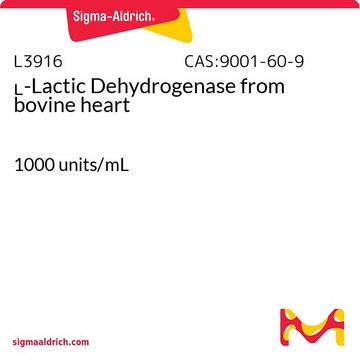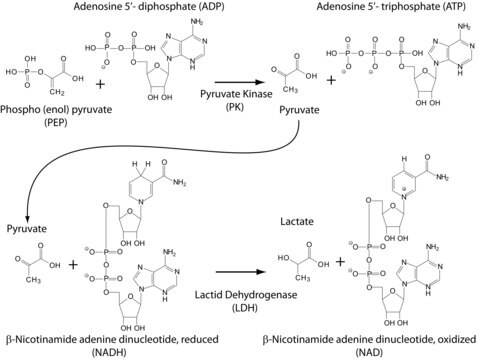LLDH-RO
Roche
L-Lactate Dehydrogenase (L-LDH)
About This Item
Prodotti consigliati
Origine biologica
rabbit muscle
Livello qualitativo
Stato
suspension
Attività specifica
~550 units/mg protein (at 25 °C (1,100 U/mg at 37 °C) with pyruvate as the substrate.)
PM
140,000 Da
Confezionamento
pkg of 10 mL (10127884001 [100 mg])
pkg of 2 mL (10127230001 [10 mg])
pkg of 5 mL (10127876001 [25 mg])
Produttore/marchio commerciale
Roche
tecniche
activity assay: suitable
Colore
white
pH
6.0-7.0
Solubilità
water: miscible
N° accesso NCBI
N° accesso UniProt
applicazioni
life science and biopharma
Attività estranea
Aldolase <0.001%
GOT <0.01%
GPT <0.01%
MDH <0.01%
PK <0.001%
myokinase <0.01%
Condizioni di spedizione
wet ice
Temperatura di conservazione
2-8°C
Informazioni sul gene
rabbit ... LOC100355262(100355262)
Descrizione generale
L-lactate dehydrogenase catalyzes the reversible reduction of pyruvate to L-lactate.
Specificità
Applicazioni
Sequenza
Therefore, 5 electrophoretically distinguishable LDH isoenzymes, LDH-1 through LDH-5, of differing subunit composition, are found in mammals.
The molecular weight of all LDH isoenzymes is approximately the same.
– LDH-1 (H4), LDH-2 (H3M): predominant components of heart LDH
– LDH-3 (H2M2): principal component of LDH from lymphatic tissue
– LDH-4 (HM3), LDH-5 (M4): predominate in skeletal muscle or liver LDH
Note: The M subunit of LDH used to be designated the A subunit; the H subunit was the B subunit. Under the old designation, LDH-1 isoenzyme was LDH-B4.
Definizione di unità
Note: For preparations H and I, the activity is defined at +30 °C, pH 7.8. The above assay consumes 1 mol of NADH per mol of pyruvate reduced.
Unit Conversion: For the reduction reaction, pyruvate as substrate:
1 U (+25 °C) 1.5 U (+37 °C) [hog muscle LDH in glycerol].
1 U (+25 °C) 1.8 U (+37 °C) [hog muscle LDH in amm onium sulfate].
1 U (+25 °C) 1.1 U (+30 °C) 2.0 U (+37 °C) [rabbit muscle LDH].
1 U (+25 °C) 1.4 U(+30 °C) 2.5 U (+37 °C) [pig heart LDH].
1 U (+25 °C) 2.5 U (+37 °C) [beef heart LDH].
Stato fisico
Nota sulla preparazione
Risultati analitici
Altre note
Codice della classe di stoccaggio
12 - Non Combustible Liquids
Classe di pericolosità dell'acqua (WGK)
WGK 1
Punto d’infiammabilità (°F)
does not flash
Punto d’infiammabilità (°C)
does not flash
Scegli una delle versioni più recenti:
Possiedi già questo prodotto?
I documenti relativi ai prodotti acquistati recentemente sono disponibili nell’Archivio dei documenti.
I clienti hanno visto anche
Il team dei nostri ricercatori vanta grande esperienza in tutte le aree della ricerca quali Life Science, scienza dei materiali, sintesi chimica, cromatografia, discipline analitiche, ecc..
Contatta l'Assistenza Tecnica.













